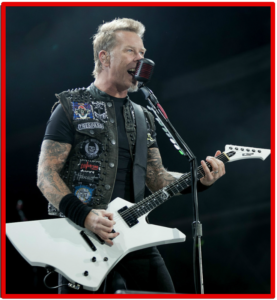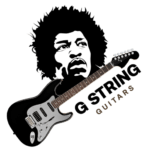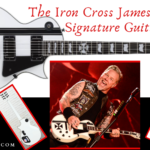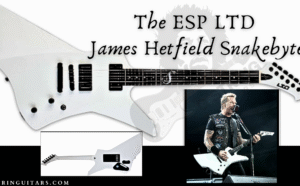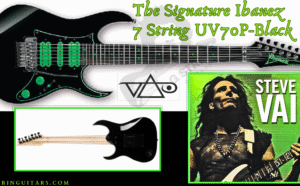This Post May Contain Affiliate Links
In compliance with the FTC guidelines, please assume that some of the links on these posts and sites are affiliate links (Amazon or others) from which I may earn a small compensation/commission from sales of certain items at no extra cost to you from qualifying purchases.
Anytime you see a link that looks like “astore.com, paid link, #ad, #CommissionsEarned or Amazon/Amazon.com/ca,”… it can be assumed that it is an affiliate link.
To learn more, follow the link below.
The ESP LTD Iron Cross James Hetfield Signature Guitar
ESP Guitar Company

ESP Company Logo-Image courtesy of en.wikipedia.org
ESP stands for Electric Sound Products and is a Japanese guitar manufacturer now based out of Tokyo and Los Angeles; and was started in 1975 by Hisatake Shibuya in Tokyo Japan.
ESP started by providing custom replacement parts for guitars and making their guitars for the Japanese market.
Setting Up Headquarters In New York City
Replacement parts for ESP were first introduced to the United States in 1983, and within 2 years, ESP was crafting custom instruments for the local New York Musicians and making bodies and necks for…
- Kramer &
- Schecter Guitars-which featured a shaved bolt-on neck heel still being used today in their designs.
Early Brand Champions
While on tour in Tokyo, George Lynch was looking for a replacement neck and discovered the company.
ESP and the Artist created the ESP Kamikaze’s first signature model guitar from this meeting.
Between 1990 and 1992 ESP Signature Series and Standard product line of guitars expanded discontinuing the replacement parts end of the company and solely focusing on the guitar and bass lines.
In 1993 ESP moved its headquarters from New York to Los Angeles.
The LTD Guitar Models
In 1995 /96, the LTD Series was created to produce ESP high-quality products at a more affordable price, similar to the lower-end ESP Guitars but more affordable and designed chiefly for markets outside Japan.
Manufacturing of the LTD lines moved to various locations, including Vietnam, China, Indonesia and Korea; the quality of these led to continued demand for the LTD series today.
The company stopped selling most of its Japanese-made flagship guitars in the US due to the high prices involved in exporting to the States until early 2000 when ESP resumed exporting the Standard Japanese made lines to the US for much higher prices.
Catering To A Wide Range Of Players
Esp guitar style models, including…
- SuperStrat
- Les Paul
- Flying V and more
ESP Technically has 2 lines…
- One for the US &
- One for Japan
ESP/Ibanez & Gibson
Ibanez was ESP’s chief competitor in Japan. Like Ibanez, the Gibson Guitar company filed a suit to prevent sales of their guitar in the Americas, forcing ESP to redesign its guitar lines to be less similar to the American Models.
Despite their legal troubles, while at a NAMM show, the company shot to fame when now avid ESP user James Hetfield and his band Metallica asked the company to work with them in creating customer guitars for the group.
ESP & Jackson Guitars
The company’s largest competitor in the states was Jackson Guitars; with both competing in the 1980s and 1990s for a market share of sales.
And in 2002, after Fender’s Buyout of Jackson Guitars, a feud between players resulted.
Many Jackson endorsers switched to ESP because they felt that Jackson’s mental Image was diluted by Fender.
And the people that stayed with Jackson said that ESP only became known for copying popular instruments, including the Jackson Soloist or Gibson Explorer.
Finding Their Audience
ESP has become one of the most popular supplies of guitars for the heavy metal niche, finding fame by making and endorsing guitars for artists from the Thrash Metal of the 1980s
in 2005 ESP Celebrated its 30th Anniversary and showcased 22 of its newest Signature Series and Standard Series models at Winter NAMM 2006; among the Brand Champions showcasing their latest ESP Models were…
- Dave Mustaine
- George Lynch and
- Michale Wilton
Today ESP is ranked one of the niche industry’s fastest-growing companies.
“Thrash Metal”
This term came from a description of an Anthrax song (Metal Thrashing Mad) from a music journalist in 1984 and has continued to be used to explain music that was fast tempoed and aggressive generated by the “big 4” thrash metal bands of the time…
- Megadeth
- Slayer
- Anthrax
- and the artist whose guitar we will look at, Metallica’s…
James Hetfield

James Hetfield, live with Metallica at Ullevi Stadium, Gothenburg, Sweden -Image courtesy of Wikimedia – Author Tommy Holl and is licensed under the Creative Commons Attribution 3.0 Unported.
James Alan Hetfield Is an American singer, composer, musician and co-founder of the thrash metal group Metallica.
Hetfield is known for his intricate rhythm-playing style and is one of the world’s most highly respected rhythm guitar players in any genre.
Hetfield leaves most of the soloing to his fellow bandmate Kirk Hammett but occasionally takes over the lead guitar duties.
Other Accolades
- Ranked 24 of 100 greatest metal vocalists of all time (Hit Parader)
- 19 greatest guitarists of all time (Guitar World)
- 87 Greatest guitarist of all time (Rolling Stone)
Metallica
Metallica’s career is long, over 4 decades, and as of 2018, the band has sold over 125 million albums worldwide with legions of loyal fans all over the world.
Releasing 10 studio albums, 4 live albums, 12 video albums, 1 cover album, 2 extended plays, 37 singles, 39 music videos and has gone on to win 9 Grammy Awards from 23 nominations. Metallica is one of the most commercially successful bands of all time.
Rolling Stone ranked them at 61 on its 100 greatest Artists of all-time list.
Hall Of Fame
April 4, 2009, saw Metallica and its remaining and former members inducted into the Rock and Roll Hall of Fame.
With no end in sight for this iconic supergroup, let’s look at one of James Hetfield’s chosen battle axes…
The ESP LTD “Iron Cross” Guitar
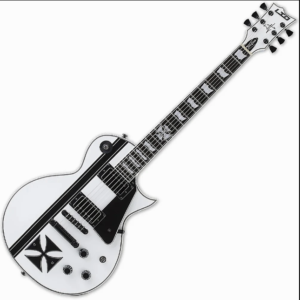
The ESP LTD Iron Cross James Hetfield Signature Guitar-Image courtesy of reverb.com
This LTD Signature Series Guitar is based on the artist’s personal custom instrument designs.
Inspired by a 1974 Gibson Les Paul and combined with a Motorcycle Hetfield was building, the Iconic Emblem used for the bike’s tanks found its way onto the black ESP Les Paul version guitar model, and the “Iron Cross” was born.
A Mahogany Body w/Maple Cap, 3-piece fast neck for improved sustain a set-neck construction, Ebony fingerboard, 22 extra-jumbo frets, TonePros locking TOM bridge & tailpiece.
Powered by Hetfield’s own EMG JH Set of active pickups and available in Black or Snow White w/stripe graphic and iron cross fixture.
Tech Specs
Body
- Body Type – Solidbody
- Body Shape – Single-cutaway electric guitar
- Body Material –Mahogany
- Top Material-Maple cap
- Body Finish-Gloss
- Color-Snow White w/distintive black stripes, James Hetfield’s signature and Iron Cross graphic artwork
- Weight- 4.99 Kilograms/11.001 lbs
- Years in Production – 2014-2022
- Country of Manufacturing –Korea
- Manufacturer Part Number-LIRONCROSSSW
Neck
- Neck Material – 3 pc Mahogany
- Neck Fretboard Material – Macassar smooth Ebony fingerboard
- Neck Shape –Thin U -shaped Contour profile neck for Ultra-fast playing and precise feel.
- Fretboard Radius- 350mm/13.7″
- Number of Frets- 22 Extra Jumbo (XJ) make it easy to hit every note with precision.
- Scale Length- 24.75″
- Nut Width- 42mm/1.650″
- Nut Material-Molded
- Tuners – LTD Locking for dependable tuning stability
- Fingerboard Inlay-Pearloid Flags with an Iron Cross inlay on the 11-13 Frets (See special features)
- Neck Joint-Set Neck
Set-neck or “Set in-neck “construction, you get stability and smooth access to the highest frets (See Image)
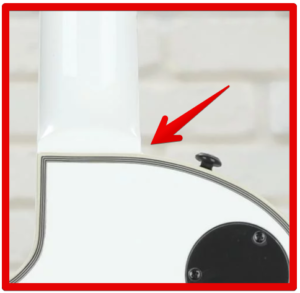
Set Neck or Set In Neck Construction-Image courtesy of sweetwater.com
What Is Meant By Set-Neck Or Set-In Neck Construction?
This term describes how a guitar’s body and guitar neck are joined together.
Types of Neck Construction
3 Main Types Of Guitar Neck Constructions
- Bolt-on
- Set neck &
- Neck-through
Bolt-on
Bolt-on-neck constructions are quite obvious.
When you turn your instrument over and see a metal plate at the junction between the guitar body and neck, with a metal plate with 4 screws to indicate where the two are bolted together, you have a Bolt-on neck.
Pros
- More Common, Cheaper and more accessible for the manufacturing and repair process
- Easy to replace or customize your guitar with different fretboards
Cons
- It offers less sustain or resonance between the neck and the body
- Because of the Heel that is created, reaching higher frets can sometimes be more challenging to execute.
- Not the best looking
Set In Necks
Set in necks is where you glue the guitar neck onto the guitar’s body.
Used almost exclusively in acoustic guitar construction and in Mid to high-range instruments.
Pros
- Set Neck guitars have more sustain and resonance than bolt-on construction.
- Clean looking
- More effortless playability in the high-fret regions
Cons
- Take much longer to build because of the glue setting waiting time in the dovetail between the neck and the body.
- Not easily replaced and would need to be left to experienced luthiers.
Neck Through Construction
Made from one continuous piece of wood and seen on high-end instruments, you have no separation in the junction between the neck and the body.
Because of this lack of separation, this design is optimum for maximum sustain, resonance, and tonal quality.
Pros
- Look and Feel Slick and Clean
- Maximum Tonal Resonance and Sustain
- Easily played in the higher fret registers
Cons
- If the neck gets damaged, it is impossible to replace, so you would need to purchase an entirely new instrument.
- It is the most expensive of the 3 types of neck construction and takes significant experience and skill to manufacture.
- Unlike the bolt-on, you cannot mix and match fretboards.
Hardware
- Strap Buttons – Schaller Strap lock
- Hardware Color – Black
- Bridge/Tailpiece- TonePros Locking Tune-O-Matic/TOM Bridge w/Stopbar Tailpiece
Electronics
EMG JH Signature Dual Set (B & N) Active Humbucker Pickups
Outside of what EMG is known for in their heavier tones of the active pickup, Hetfield wanted the ability to get a cleaner sound characteristic of clarity and punch being created by the passive EMG pickup.
The artist went to EMG and asked to create the union of the two and give it a sleeker look.
EMG and James Hetfield went on a 2-year journey to make this happen, and EMG delivered in a big way.
The Result
- A Neck pickup (Ceramic)- with higher output, beefier low-end and fuller attack.
- A Bridge pickup (Steel Poles)– for a tighter attack and cleaner lows.
Giving you Massive sonic tenacity with clear, punchy or aggressive tones.
Having ESP and EMG at his side, the artist could not be happier…
“This combination is heaven for me.”
James Hetfield
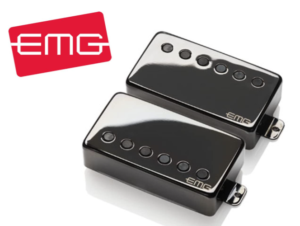
To Get Your EMG JH James Hetfield Signature Guitar Pickup Set, Black Chrome, Click On The Image Here.
Controls With A Twist
- Controls- 2 x Volume, 1 x Master Tone
- Switching – 3-Way Toggle Switch (Bottom)/3-way Toggle Switch (Top) is inactive.
The top 3-way toggle switch is not wired and is just for cosmetics; Hetfield likes his toggle switches on the bottom close to his controls but felt that not having the switch in the standard position took away from the cosmetic appeal of the guitar. (See Image)

The top 3-way toggle switch is for show only-Image, courtesy of amazon.com
Special Features
Signature Headstock
You get the Hetfield artist’s signature on the headstock along with the name of the guitar on the truss rod cover (See Image)
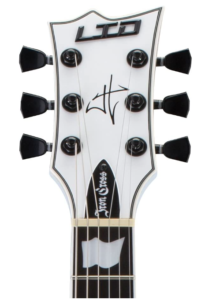
The ESP LTD James Hetfield “Iron Cross” w/Artist signature and model name on Truss rod cover-image courtesy of amazon.com
Iron Cross Inlay
You get the iron cross inlay on the 11-13 fret to complement the iron cross on the guitar’s body. (See Image)
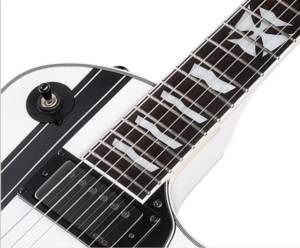
Pearloid Flags with an Iron Cross inlay on the 11-13 Frets-Image courtesy of amazon.com
Multi-Ply Binding
Multi-Ply Binding on the body’s top and back along with the neck and headstock.
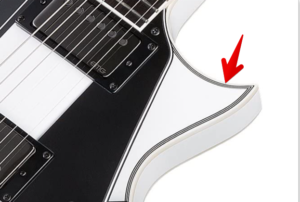
Multi-Ply Binding-Image courtesy of amazon.com
Along with an ESP EC form-fit guitar hard case to safely transport.
Video
Final Thoughts
This guitar is built to be comfortable and functional with a great blend of classic and modern tones.
I am a big fan of the classics and can see where this model fits into your tools of axes.
The EMG pickups are a no-brainer; I am a fan of the brand and have them in two of my guitars; they say pickups find you, and they certainly did for me.
The set-in neck is an excellent addition to this guitar for extra sustain and playability.
Like the Les Paul, which weighs between 9-12 lbs, this battle-axe is at the higher end of weight (11 Lb), so that could make it playing all night on stage difficult, even with a broader strap for support.
Also, you can see how versatile this guitar is, and you will find no issues with the level of hardware and craftsmanship.
This made-in-Korea instrument is a bit pricey and very distinctive, so like with most signature models, some can be your own, and some are more identifiable.
This guitar says, “I am a fan of Metallica and am proud to play this guitar and have a small piece of the legacy.”
Should You Add This To Your Collection
If you are a fan of the iconic band and do not mind the distinctive look, yes.
The combination of the classic shape, the ESP craftsmanship and quality, along with the EMG Electronics, makes this a very appealing instrument.
Did You Like This Article?
Check out my review of the Zakk Wylde Gibson Les Paul Custom
Also…
Leave me your comments in the section below, and if you would like me to review a favourite guitar.
As always, stay the course and keep playing.
Feature image of artist courtesy of Wikimedia.com- Author Gláucio Burle and is licensed under the Creative Commons Attribution-Share Alike 4.0 International
Front and back image of guitar courtesy of Sweetwater.com and Amazon.com
Image of EMG JH James Hetfield Signature Guitar Pickup Set, Black Chrome, courtesy of Amazon
Main guitar image courtesy of Amazon.com

Starting A Journey At 7 Years Of Age, The Love For The Guitar Only Became Stronger Going Into My Teens. This Leading To An Exciting Time Of Teaching, Performing, And Recording. Join Me Now As We Can Bring The Love Of This Instrument To Other Musicians Globally.


